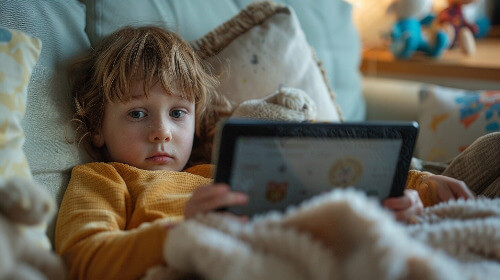Screen Time for Kids: A Balanced Approach
Let's get into the topic that's on many of our minds: screen time for kids. We all face this problem with our kids, and I’d like to make some suggestions how to deal with it, but keep in mind, there’s no guarantee especially if you're talking about kids over the age of 10.
How Much Screen Time is Appropriate for My Child?
First things first, how much is too much? The American Academy of Pediatrics (AAP) suggests:
If your child is aged 2 to 5 years: Limit the screen time for kids of this age to 1 hour per day of good-quality programming.
For children aged 6 years and older: Set consistent limits to ensure screen time doesn't interfere with sleep, physical activity, or other healthy behaviors.
It’s all about finding that sweet spot where screens can be educational and entertaining without taking over.
Monitoring and Controlling Your Child's Online Activity
Keeping tabs on your child's online activity can feel overwhelming, but it’s crucial. Here are some tips:
Use Parental Controls: Many devices and apps offer parental control settings. Use them to block inappropriate content and set screen time limits.
Create a Family Media Plan: Sit down together and set rules about screen use. This could include no screens during meals, homework time, or before bed.
Stay Engaged: Regularly check in with your child about what they’re watching or playing. Encourage them to share their favourite apps or shows with you.
The Effects of Screen Time for Kid's on Development
Screen time can affect children in various ways, both positively and negatively. Let's break it down:
Positive Effects:
- Educational Value: High-quality educational programs and apps can boost learning and skill development.
- Social Connection: Video calls with family and friends can strengthen relationships, especially when in-person meetings aren't possible.
Negative Effects:
- Physical Health: Excessive screen time can lead to inactive behavior, contributing to obesity and other related health issues.
- Mental Health: Too much screen time, especially on social media, can lead to anxiety, depression, and poor self-esteem.
- Sleep Disruption: Screens before bed can interfere with sleep quality and duration.
Encouraging Outdoor Play and Physical Activity Instead
Getting kids to unplug and play outside is vital for their health and well-being. Here’s how you can encourage it:
- Set an Example: Be a role model by being active yourself. Go for family walks, bike rides, or play sports together.
 Seven young children riding their bikes outside on the rode.
Seven young children riding their bikes outside on the rode.- Create a Fun Outdoor Environment: Make your backyard or local park inviting with toys, games, and activities that encourage physical play.
- Limit Indoor Options: Reduce the attraction of screens by limiting their availability during certain hours and providing exciting alternatives.
The Best Educational Apps and Programs for Children
Not all screen time is created equal. One way to make screen time productive for your child is to include some of these top educational apps and programs into their library.
- ABCmouse: This app offers a early learning program for kids aged 2-8, that teaches reading, math, science, and art. It's free to download at Amazon.
- Khan Academy Kids: A fun educational program for children ages 2-7, it features books, videos and activities to help your child grow. And it’s free! to download at Amazon.
- Duolingo: A fantastic app for older kids and even adults to learn new languages through engaging, game-like lessons. Free download at Amazon.
- Tynker: Perfect for those who want to learn about programming, Tynker teaches kids coding through interactive stories and games.
Providing these educational apps to children when they are young may (but are not guaranteed to) encourage kids from the use of violent video games in the future.
Balancing Screen Time and Other Activities
Finding a balance is key. Some suggestions that will help you to manage screen time for kids more effectively are:

- Establish a Routine: Each day provide a schedule that includes time for homework, chores, physical activity, and screen time. Keep it consistent.
- Prioritize Tasks: Make sure screens are used only after essential tasks like homework and chores are completed.
- Encourage Hobbies: Help your child discover and develop hobbies that don’t involve screens, like reading, drawing, or playing a musical instrument.
Understanding the Role of Screens in Today’s World
In our digital age, screens are unavoidable. They play a meaningful role in entertainment, education and even communicating with others.
It’s not about eliminating screens but about teaching our children how to use them wisely.
Tips for Healthy Screen Time Habits
Here are some additional tips to ensure your child develops healthy screen time habits:
- Be Mindful of Content: Ensure the content your child is consuming is age-appropriate and beneficial.
- Discuss Online Safety: Teach your child about online safety, including the importance of not sharing personal information and recognizing cyberbullying.
- Encourage Breaks: Remind your child to take regular breaks to rest their eyes and move around.
Creating a Positive Digital Environment
To make screen time for kids a positive experience, consider the following:
- Play Together: Watch and play alongside your child to make screen time interactive and educational.
- Use Screens Purposefully: Encourage your child to use screens for creative and educational purposes rather than just inactivity.
- Promote Critical Thinking: Discuss the content they view, asking questions that will help them to think seriously about what they see.
Dealing with Resistance
It’s normal for kids to resist limits on screen time. Here’s how to handle it:
- Remain Firm but Flexible: Be consistent with rules but open to discussions and adjustments as needed.
- Offer Choices: Give your child some control by letting them choose between different non-screen activities.
- Positive Reinforcement: Praise and reward your child for adhering to screen time limits and engaging in other activities.
 Teenage girl is holding up her phone and smiling.
Teenage girl is holding up her phone and smiling.Finally, remember that screen time for kids is a topic that requires careful consideration and balance.
When you set clear limits and remain involved in your child’s screen time activities, you can encourage a mix of the digital world and physical activities.
An example of Adult Role Modelling
I could be wrong here, so do correct me if you do not agree. I feel that one of the biggest problems lies with parents and adults being on their phones constantly. It looks like the cool & right thing to do, so that's what kids want to do too.
Adults walk while on their phones, they drive in their cars while on their phones. I've seen mom's pushing their kids in strollers while on their phones. Crossing the street while on their phones.
And I don't just mean talking on them, but texting with their heads down, not watching where they're going.
Eg. 1 One day I saw a mom on her phone, head down and her little girl, she was about 6, was also on a device all while they were walking.
The little girl didn't see me and my dog coming towards them. Because she was looking down at her game and not paying attention she almost tripped over my dog.
She wasn't happy with him and neither was her mom. Here's the thing, it wasn't my dogs fault that they weren't watching where they were going.
I calmly said to the mom, "that likely would not have happened if you were not on your devices."
Was it mean to say, maybe. Or maybe I should have apologized. Nope, they were the ones who weren't watching where they were going. But they learned a lesson and both put their devices away when I turned to look back at them.
Eg. 2 My neighbour, she occasionally brings her kids out to play (4 kids) and she sits out on the deck to watch them, but for the most part she is on her phone texting or social media or whatever.
The Problem: First, the kids are not being properly supervised. Second, she is being a bad role model. Third, I've heard the kids calling her, mom, mom, mom, mom, mom, 10 or 15 times before she finally answers them. I mean, they could be hurt.

























New! Comments
Have your say about what you just read! Leave me a comment in the box below.